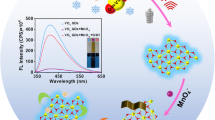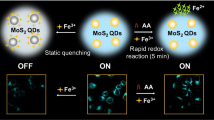Abstract
A rapid, selective and sensitive sensor based on the Fe(III) modulated nitrogen-doped graphene quantum dots (N-GQDs) was developed and applied as fluorescence sensor for ascorbic acid (AA) detection. The N-GQDs was one-step synthesized in an easy and green way using citric acid as the carbon source and urea as nitrogen source. The sensor was based on the different quenching effects of Fe(III) and Fe(II) on the fluorescence intensity of N-GQDs. The fluorescence of N-GQDs was quenched by Fe(III) via the strong selective coordination interaction between them. In the presence of AA, Fe(III) can be transformed to Fe(II) ascribed to the oxidation-reduction reaction, leading to the recovery of fluorescence. On the basis of this principle, a fluorescence sensor for AA detection was constructed. Under optimal conditions, the method showed a response to AA within a concentration range of 1.0–90 μmol L−1 with a good linear relationship and the detection limit for AA was 18 nmol L−1. The developed sensor was successfully applied for the determination of AA in beverage samples with quantitative recoveries from 95.3 % to 104.3 %.









Similar content being viewed by others
References
Li L, Cai XY, Ding YP, Gu SQ, Zhang QL (2013) Synthesis of Mn-doped CdTe quantum dots and their application as a fluorescence probe for ascorbic acid determination. Anal Methods 5:6748–6754
Zhu XH, Zhao TB, Nie Z, Liu Y, Yao SZ (2015) Non-redox modulated fluorescence strategy for sensitive and selective ascorbic acid detection with highly photoluminescent nitrogen-doped carbon nanoparticles via solid-state synthesis. Anal Chem 87:8524–8530
Wu T, Guan YQ, Ye JN (2007) Determination of flavonoids and ascorbic acid in grapefruit peel and juice by capillary electrophoresis with electrochemical detection. Food Chem 100:1573–1579
Shintani H (2013) HPLC analysis of ascorbic acid (vitamin C). Pharmaceutica Analitica Acta 4:5
Valente A, Sanches-Silva A, Albuquerque TG, Costa HS (2014) Development of an orange juice in-house reference material and its application to guarantee the quality of vitamin C determination in fruits, juices and fruit pulps. Food Chem 154:71–77
Klimczak I, Gliszczyńska-Świgło A (2015) Comparison of UPLC and HPLC methods for determination of vitamin C. Food Chem 175:100–105
Zhu Q, Dong D, Zheng XJ, Song HQ, Zhao XR, Chen HL, Chen XG (2016) Chemiluminescence determination of ascorbic acid using graphene oxide@copper-based metal–organic frameworks as a catalyst. RSC Adv 6:25047–25055
Chen HJ, Li W, Zhao P, Nie Z, Yao SZ (2015) A CdTe/CdS quantum dots amplified graphene quantum dots anodic electrochemiluminescence platform and the application for ascorbic acid detection in fruits. Electrochim Acta 178:407–413
Yang LQ, Huang N, Lu QJ, Liu ML, Li HT, Zhang YY, Yao SZ (2016) A quadruplet electrochemical platform for ultrasensitive and simultaneous detection of ascorbic acid, dopamine, uric acid and acetaminophen based on a ferrocene derivative functional Au NPs/carbon dots nanocomposite and grapheme. Anal Chim Acta 903:69–80
Sheng ZH, Zheng XQ, Xu JY, Bao WJ, Wang FB, Xia XH (2012) Electrochemical sensor based on nitrogen doped graphene: simultaneous determination of ascorbic acid, dopamine and uric acid. Biosens Bioelectron 34:125–131
Chen YT, Chen XP, Lin ZY, Dai H, Qiu B, Sun JJ, Zhang L, Chen GN (2009) An electrically heated ionic-liquid/multi-wall carbon nanotube composite electrode and its application to electrochemiluminescent detection of ascorbic acid. Electrochem Commun 11:1142–1145
Yu ZY, Li HJ, Lu JH, Zhang XM, Liu NK, Zhang X (2015) Hydrothermal synthesis of Fe2O3/graphene nanocomposite for selective determination of ascorbic acid in the presence of uric acid. Electrochim Acta 158:264–270
Zhao JJ, Zhao LM, Lan CQ, Zhao SL (2016) Graphene quantum dots as effective probes for label-free fluorescence detection of dopamine. Sensors Actuators B Chem 223:246–251. doi:10.1016/j.snb.2015.09.105
Wang D, Chen JF, Dai LM (2015) Recent advances in graphene quantum dots for fluorescence bioimaging from cells through tissues to animals. Part Part Syst Charact 32:515–523
Lin LP, Rong MC, Luo F, Chen DM, Wang YR, Chen X (2014) Luminescent graphene quantum dots as new fluorescent materials for environmental and biological applications. Trends Anal Chem 54:83–102
Qian ZS, Ma JJ, Shan XY, Shao LX, Zhou J, Chen JR, Feng H (2013) Surface functionalization of graphene quantum dots with small organic molecules from photoluminescence modulation to bioimaging applications: an experimental and theoretical investigation. RSC Adv 3:14571–14579
Kumar GS, Roy R, Sen D, Ghorai UK, Thapa R, Mazumder N, Saha S, Chattopadhyay KK (2014) Amino-functionalized graphene quantum dots: origin of tunable heterogeneous photoluminescence. Nanoscale 6:3384–3391
Dong YQ, Wang RX, Li GL, Chen CQ, Chi YW, Chen GN (2012) Polyamine-functionalized carbon quantum dots as fluorescent probes for selective and sensitive detection of copper ions. Anal Chem 84:6220–6224
Fan ZT, Li YC, Li XH, Fan LZ, Zhou SX, Fang DC, Yang SH (2014) Surrounding media sensitive photoluminescence of boron-doped graphene quantum dots for highly fluorescent dyed crystals, chemical sensing and bioimaging. Carbon 70:149–156
Li SH, Li YC, Cao J, Zhu J, Fan LZ, Li XH (2014) Sulfur-doped graphene quantum dots as a novel fluorescent probe for highly selective and sensitive detection of Fe3+. Anal Chem 86:10201–10207
Liu Y, Yan K, Okoth OK, Zhang JD (2015) A label-free photoelectrochemical aptasensor based on nitrogen-doped graphene quantum dots for chloramphenicol determination. Biosensor and Bioelectronics 74:1016–1021
Dey S, Govindaraj A, Biswas K, Rao CNR (2014) Luminescence properties of boron and nitrogen doped grapheme quantum dots prepared from arc-discharge-generated doped grapheme samples. Chem Phys Lett 595-596:203–208
Qu D, Zheng M, Du P, Zhou Y, Zhang LG, Li D, Tan HQ, Zhao Z, Xie ZG, Sun ZC (2013) Highly luminescent S, N co-doped graphene quantum dots with broad visible absorption bands for visible light photocatalysts. Nanoscale 5:12272–12277
Lin LP, Song XH, Chen YY, Rong MC, Zhao TT, Jiang YQ, Wang YR, Chen X (2015) One-pot synthesis of highly greenish-yellow fluorescent nitrogen doped graphene quantum dots for pyrophosphate sensing via competitive coordination with Eu3+ ions. Nanoscale 7:15427–15433
Sahoo SK, Sharma D, Bera RK, Crisponi G, Callan JF (2012) Iron(III) selective molecular and supramolecular fluorescent probes. Chem Soc Rev 41:7195–7227
Lu WJ, Gong XJ, Nan M, Liu Y, Shuang SM, Dong C (2015) Comparative study for N and S doped carbon dots: synthesis, characterization and applications for Fe3+ probe and cellular imaging s. Anal Chim Acta 898:116–127
Chen SF, Song Y, Li Y, Liu YL, Su XG, Ma Q (2015) A facile photoluminescence modulated nanosensor based on nitrogen-doped grapheme quantum dots for sulfite detection. New Journal of Chemisty 39:8114–8120
Kong Y, Shan XL, Ma JF, Chen ML, Chen ZD (2014) A novel voltammetric sensor for ascorbic acid based on molecularly imprinted poly (o-phenylenediamine-co-o-aminophenol). Anal Chim Acta 809:54–60
Wen D, Guo SJ, Dong SJ, Wang EK (2010) Ultrathin Pd nanowire as a highly active electrode material for sensitive and selective detection of ascorbic acid. Biosens Bioelectron 26:1056–1061
Huang S, Qiu HN, Zhu FW, Lu SY, Xiao Q (2015) Graphene quantum dots as on-off-on fluorescent probes for chromium(VI) and ascorbic acid. Microchim Acta 182:1723–1731
Liu JJ, Chen ZT, Tang DS, Wang YB, Kang LT, Yao JN (2015) Graphen quantum dots-based fluorescent probe for turn-on sensing of ascorbic acid. Sensors Actuators B Chem 212:214–219
Author information
Authors and Affiliations
Corresponding author
Rights and permissions
About this article
Cite this article
Kong, X., Gong, Y. & Fan, Z. The Sensitive Turn-On Fluorescence Detection of Ascorbic Acid Based on Iron(III)-Modulated Nitrogen-Doped Graphene Quantum Dots. J Fluoresc 26, 1755–1762 (2016). https://doi.org/10.1007/s10895-016-1867-3
Received:
Accepted:
Published:
Issue Date:
DOI: https://doi.org/10.1007/s10895-016-1867-3




